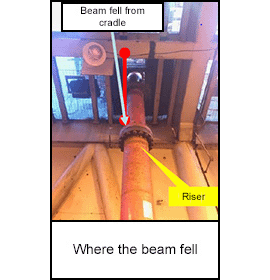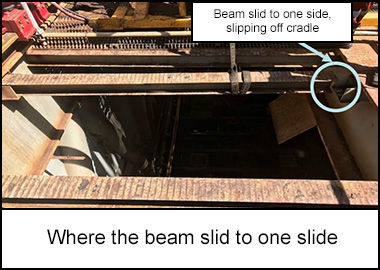-
What happened?
A riser had been put in place for well work.
During a high sea swell, it rubbed on a 54kg (120lbs) removable I-beam that supported the deck grating.
The I-beam fell 55 ft (17 metres) to the deck below.
No operation or work was being performed at the time so there were no injuries.

-
Why did it happen?
The beam was designed to be removable to allow riser installation.
The riser had been unchained (as per procedure) however, sea swell caused the unchained riser to rub against the I-beam.
These I-beams had been installed more than 30 years ago.
The I-beam did not have travel stops, however some I-beams did (a similar incident happened several years ago but that I-beam did not fall).

-
What did they learn?
Add travel stops on the bottom of all removable beams at both ends.
Barricade well bay sections (all decks) until all beams are modified.
The I-beams should have been replaced having been installed more than 30 years ago.

-
Ask yourself or your crew
How could this happen here?
What safety measures (i.e. procedures, controls/barriers) do we have in place to mitigate the risk?
When was our equipment installed and is it still safe and fit for purpose?

Add to homescreen
Content name
Select existing category:
Content name
New collection
Edit collection
What happened?
A riser had been put in place for well work.
During a high sea swell, it rubbed on a 54kg (120lbs) removable I-beam that supported the deck grating.
The I-beam fell 55 ft (17 metres) to the deck below.
No operation or work was being performed at the time so there were no injuries.

Why did it happen?
The beam was designed to be removable to allow riser installation.
The riser had been unchained (as per procedure) however, sea swell caused the unchained riser to rub against the I-beam.
These I-beams had been installed more than 30 years ago.
The I-beam did not have travel stops, however some I-beams did (a similar incident happened several years ago but that I-beam did not fall).

What did they learn?
Add travel stops on the bottom of all removable beams at both ends.
Barricade well bay sections (all decks) until all beams are modified.
The I-beams should have been replaced having been installed more than 30 years ago.
Ask yourself or your crew
How could this happen here?
What safety measures (i.e. procedures, controls/barriers) do we have in place to mitigate the risk?
When was our equipment installed and is it still safe and fit for purpose?
An I-beam fell 55 ft (16.7 metres) to the deck below. This was due to it rubbing against an unsecured riser during a high sea swell. There were no injuries.














